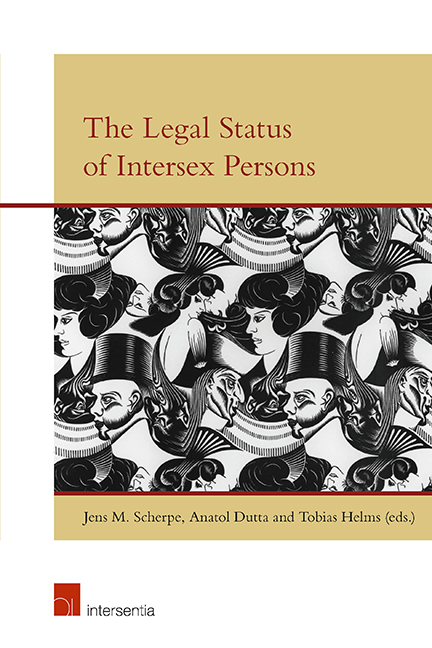Book contents
- Frontmatter
- Preface
- Contents
- List of Contributors
- The Legal Status of Intersex Persons: An Introduction
- Malta Declaration
- Darlington Statement
- Vienna Statement
- PART I MEDICINE AND PSYCHOLOGY
- PART II THEOLOGY AND LEGAL HISTORY
- PART III TRANSGENDER, TRANSSEXUALITY AND INTERSEX
- PART IV NATIONAL LEGAL DEVELOPMENTS
- Australia
- Sweden
- India
- The Netherlands
- France
- Colombia (The Colombian Constitutional Court)
- United States
- Malta
- Germany (The 2013 German Law)
- Germany (German Inter-Ministerial Working Group)
- Germany (Gender Diversity in Law)
- PART V PRIVATE INTERNATIONAL LAW ASPECTS OF INTERSEX
- PART VI INTERSEX AND HUMAN RIGHTS
The Netherlands
from PART IV - NATIONAL LEGAL DEVELOPMENTS
Published online by Cambridge University Press: 31 January 2019
- Frontmatter
- Preface
- Contents
- List of Contributors
- The Legal Status of Intersex Persons: An Introduction
- Malta Declaration
- Darlington Statement
- Vienna Statement
- PART I MEDICINE AND PSYCHOLOGY
- PART II THEOLOGY AND LEGAL HISTORY
- PART III TRANSGENDER, TRANSSEXUALITY AND INTERSEX
- PART IV NATIONAL LEGAL DEVELOPMENTS
- Australia
- Sweden
- India
- The Netherlands
- France
- Colombia (The Colombian Constitutional Court)
- United States
- Malta
- Germany (The 2013 German Law)
- Germany (German Inter-Ministerial Working Group)
- Germany (Gender Diversity in Law)
- PART V PRIVATE INTERNATIONAL LAW ASPECTS OF INTERSEX
- PART VI INTERSEX AND HUMAN RIGHTS
Summary
INTRODUCTION
When Katja in her late puberty still had not had her period, her mother sent her to the doctor. This was the start of a two-year medical tour from one expert to the other. Their conclusion was that Katja had no pubic hair and no uterus, but why that was so remained unclear, at least to Katja. Most confusing was that Katja's mother made her promise not to talk to anyone about the'secrets in her tummy ‘. It was only when Katja was in her forties that she discovered that she had an XY, thus ‘male’ chromosomal make-up. Even more shocking was the discovery that her parents and her doctors had known this all along. The decision to keep this knowledge from Katja was based on a medical protocol according to which children with irregular sex characteristics were told as little as possible, to avoid ‘gender confusion’. The protocol had been adopted in the Netherlands following the then famous (now infamous) John/Joan case of American doctor John Money, who believed in the possibility to raise children in a specific gender, regardless of their physical characteristics. To ensure the successful gender development of a child as – in this case – female, it was imperative to keep any information from Katja that might raise doubts about her gender. Thus, it made sense not to tell Katja about her chromosomal make-up.
Katja was born in the early 1940s, but her experiences are shared by generations of people after her, since the medical protocol to not disclose information to intersex/DSD individuals that potentially could cause ‘gender confusion’, was only abandoned around 2003.
The main impetus to change the policy of secrecy regarding sex variations seems to have come from the spread of the World Wide Web: with access to the internet increasing, it became impossible to keep medical facts from the general public. The internet disclosed medical information on intersex conditions that had hitherto been accessible only to the medical profession. This in turn made many individuals with an intersex condition realise they were not in fact unique, as they had been led to believe.
- Type
- Chapter
- Information
- The Legal Status of Intersex Persons , pp. 293 - 304Publisher: IntersentiaPrint publication year: 2018

